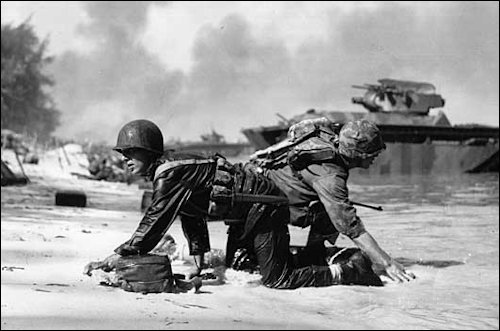A few days ago, Bacon’s Rebellion featured a tribute to the 75th anniversary of D-Day in Normandy. The critically important invasion opened up a second front against Nazi Germany, leading to its defeat and the end of its terror.
This weekend, I propose another commemoration – that of the 75th anniversary of the U.S. invasion of Saipan in the Pacific Ocean. It is also a Father’s Day tribute of sorts that has links to Bacons Rebellion.
Saipan is in the Mariana Islands in the Central Pacific. Admiral Chester Nimitz wanted to seize the islands for air bases from which aircraft could bomb the Japanese mainland and. The Marianas also could serve as a staging ground for the eventual invasion of Japan.
On June 15, 1944, an invasion force led by the U.S. Marine Corps attacked Saipan after days of bombardment. The campaign would run until July 9 and would cost the lives of more than 29,000 troops on both sides.
After seizing Saipan, U.S. forces then stormed the island of Tinian, a short distance from Saipan. There, a gigantic bomber base was build to handle B-29s. A little more than a year later, B-29s based on Tinian flew the two atomic missions against Japan.
First, though, came heavily fortified Saipan. The Marines had learned from previous bloody island invasions that it was vital that landing craft not get hung up on impediments such as coral reefs. Otherwise, troops would be slaughtered by Japanese fire.
They came up with the Landing Vehicle Tracked (LVT), an amphibious tractor that originated in the swamps of Florida. LVTs could clamber over coral and take troops directly onto beaches.
Still, there were heavy losses. So, another weapon was developed. One version was the LVT (A) 4, which was an LVT with a turret housing a 75-millimeter howitzer capable of taking out enemy bunkers. Some versions had flamethrowers. The armed LVTs would usually advance ahead of the troops carrying LVTs to lay down covering fire.
One LVT (A) 4 unit was the 2nd Armored Amphibian Battalion that led the 2nd Marine Division’s assault on Saipan. The unit had been formed in California and, after training on Hawaii, went into combat for the first time.
The 2nd Armored succeeded after weeks of bloody fighting. The unit also helped spearhead assaults on Tinian and Iwo Jima, perhaps the most famous battle of the Pacific War.
What’s the connection to Bacon’s Rebellion and Father’s Day?
The father of Reed Fawell who is a real estate expert and regular contributor to Bacon’s Rebellion commanded the 2nd Armored. The Battalion Surgeon, a 28-year-old Navy doctor, was my father.
For more information, check out this Website that Reed helped put together a few years ago.
Peter Galuszka, a Richmond-area writer, is an occasional contributor to Bacon’s Rebellion.


Leave a Reply
You must be logged in to post a comment.